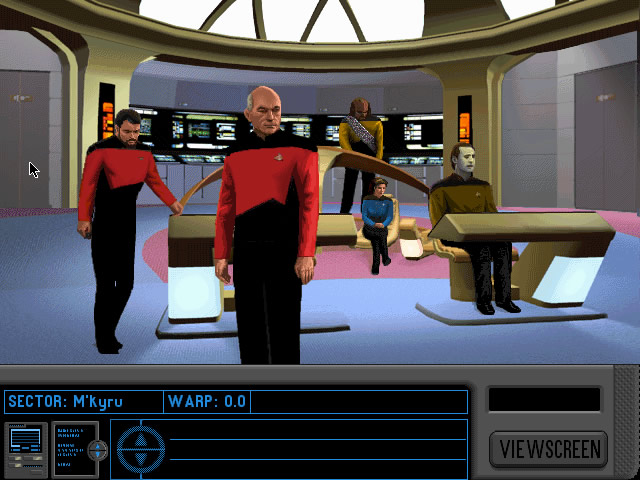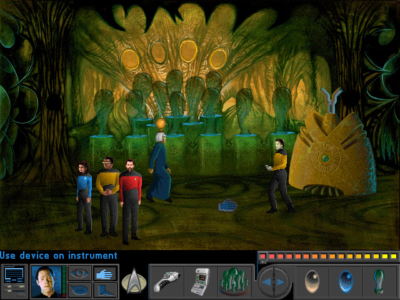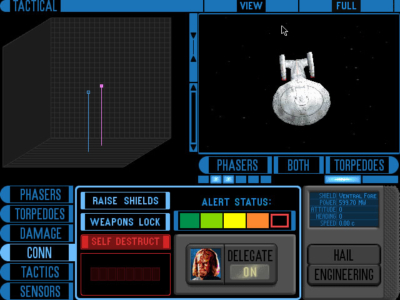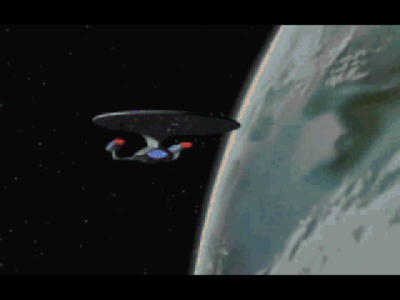
Star Trek the Next Generation: A Final Unity
Written by: Stoo
Date posted: March 17, 2007
- Genre: Adventure
- Developed by: Spectrum HoloByte
- Published by: Microprose
- Year released: 1994
- Our score: 7
The scene: the Starship Enterprise-D has encountered an alien vessel of unknown and highly unusual configuration. So far, they have been unable to establish communications with the aliens. Captain Picard, slightly cautious but enthusiastic about this first-contact situation, asks for suggestions. Counsellor Troi detects “curiosity” from the aliens, but then last week she detected “anger” in a Klingon commander whose only son had been murdered by Cardassian spies. Worf suggests opening fire on the alien ship, just in the off-chance it’s dangerous. Commander Data suggests that a [tech] emitter can be modified to produce [tech] waves of a form that the aliens can receive and understand. Geordi LaForge is all “hey yeah if we just divert power from the [tech] generators”. Picard decides that’s the right course of action. He nods: “Make it so.” Commander Riker throws in a “yeah you guys do that” to try and look like he’s giving some useful input here. Worf assumes since they’re not shooting yet, people somehow didn’t hear him and patiently repeats his request.
I kid because I love. I wouldn’t bother trying to hide the fact that I’m a Trekkie, and especially enjoyed The Next Generation. From an early age I was inspired by its spirit of intrepid exploration and adventure, encountering the unknown in deep space. Also, behind all the aliens and science, the show raised ethical questions and explored the human condition – often using aliens as mirrors for some aspect of our nature. What’s more, it did all this in a manner that was unashamedly optimistic about the future. Maybe unrealistically so – and there’s plenty of other sci-fi if you want something darker or grittier. Still TNG showed us some worthy goals to aspire towards, and characters driven by a desire to better themselves. Sure a few of the episodes were a little dull and the show put some off with its made-up technobabble. Oh, and we had to occasionally endure Troi’s mother. Still, it’s one of the greatest pieces of TV sci-fi to date.
So then I, like a lot of others, fall into that significant overlap between the two geek realms of Trekkies and Gamers. I think it’s fair to say we’ve been well catered to over the years. Starfleet Academy, Armada and Elite Force, just to name a few of the more prominent of the numerous Trek games on PC. Off the top of my head I couldn’t tell you what the first of their kind was; I’m sure Mobygames could help us out. One of the first noteworthy commercial titles though was Star Trek: 25th Anniversary, which still carries my recommendation. Based on the original series, it’s a hybrid of point-and-click adventure and very basic enterprise-simulator. An upbeat and colourful affair, it captured the spirit of the original series very well.
I use that as a reference point because the game we’re talking about today, Final Unity isn’t an official sequel but follows a similar template based this time on TNG. Once again your time is divided between two aspects: one is commanding the Starship Enterprise. The simulation aspect is rather more detailed than in 25th anniversary, but again serves to move the focus from one planet to the next and provide some ship-to-ship combat. Then there are regular away missions – Trek speak for “officers beam down to some location, possibly quite dangerous, to do some exploring or investigate something”. That’s where the point-and-click adventuring comes in.
The game begins with some pre-rendered video clips. We see the Enterprise cruising past on some routine mission to scan comets (or something equally peaceful and sciencey), when they spot a tiny little Garidian scoutship racing towards them. Nope, we’ve not heard of Gardians before, but apparently they’re a minor race within the Romulans’ sphere of influence. When the scout reaches Enterprise, its crew request political asylum. Just as Picard is mulling this over, however, a huge and powerful Gardian warship appears behind the scout. Uh-oh! Cue dramatic chords, and… just like the opening scenes of the TV show, that was the teaser.
From here, we’re shown a faithful rendition of the old TV title sequences. Ten years ago this whole intro looked rather spectacular. Nowadays, the 3D renderings of the Trek cast look stiff and plastic, but the Enterprise is convincing enough. Overall, it still feels rather authentic. Since adventures were by their nature story-driven games, it’s certainly a good way to start that story, giving it a feel of “take command of your own episode of your favourite TV show”.
That done, you’re given command of the Enterprise. The idea here is that you can if you wish take full control of the ship. Starting from a screen showing the crew on the bridge, you can directly operate the control stations for navigation, combat and engineering. Or, you can set these functions to run automatically, under the guise of delegating to your bridge officers. In that case you’re left with only the command-level decisions that Picard would make, like “do we chase that ship or proceed to our rendezvous at the archaeological site?”. You can also prompt bridge officers for advice. Commander Data normally has something clever and technical on offer, Troi is more of a people person and Riker just kind of slouches around.
A good idea on paper then. Unfortunately, if you fancy having a go at the hands-on approach, you might come away disappointed. Well, navigation isn’t too bad. Set co-ordinates, speed, hit go. You’re given freedom to roam around a large area of space, however it’s quickly revealed that in reality this is fairly pointless. If you visit anywhere other than a location specified in your mission objectives, you’ll find there’s nothing to do there except sit in orbit. Or possibly get shot at by Romulans. In all fairness though this is a Star Trek adventure, not Star Trek: Elite. So while a more non-linear approach might have been interesting, the lack of true freedom of movement isn’t really a major point against the game.
Combat, however, is just plain confusing. The setup seems simple enough – map in one quarter of the screen, 3D display in another, various commands beneath. Still I never quite worked out the controls – or what effect the buttons I was hitting was having on anything – so whirled around the map randomly for a bit, delegated to Mr Worf and never touched it again. Engineering meanwhile is all about allocating power resources from the main reactor, to functions like shields and engines. So I guess it could be fun as an additional dimension to combat. However, if you’ve already got the combat interface on auto, it’s unlikely you’ll derive much enjoyment from sitting there adjusting lots of little glowing bar-charts.
Thus this whole side of the game falls a little flat. Of course, it’s possible I’m just being dense, but I honestly never felt like it was making an effort to get me involved here. So during the repeated random encounters with Romulan warships, I just sat there staring in mild disinterest whilst Worf fired torpedoes and declared “direct hit” until they were over. Except for when Enterprise got jumped by 2 enemies at once and was destroyed. Bah.
The good news is, the adventuring aspect works better. To begin each away mission you choose which officers to send – the idea being that each has their own skills or knowledge, and you must decide who would be the most useful. If there could be sick or injured down there, Doctor Crusher is the obvious choice. If the mission requires expertise in engineering or technology, send Geordi Laforge. If women need to be charmed by rugged manliness send Riker (note: this situation may not actually occur).
Once beamed down, you’re firmly in familiar old point-and-clicker territory. Puzzles are quite logical, and there aren’t any annoying action or reflex-based interludes. In fact, although you carry phasers, there’s never any need to use them for anything more violent then clearing debris..
The first mission involves coming to the aid of a major space station that’s suffered an accident, later on you’re investigating a murder at a wildlife reserve and meeting an enigmatic hidden order of monks on a remote world. Because of its mission-based structure, each section is relatively short and largely unconnected to the others, aside from overarching story elements. So solving puzzles involves looking at the local situation and not worrying so much about if you remembered some item from another planet.
Through these two sides of the game the overall story develops, involving an ancient, long forgotten empire and a device of great power. It’s competently done, although I wish I could use more glowing terms than that. The final chapter poses one or two questions – as good Trek should – about what should be done with aforementioned great power, which is a sound enough basis for storytelling. Still the journey there is just a little bland and dispassionate. The characters never quite come to life, beyond a level of professional interest in their mission, and it’s hard to get a sense of drama or high stakes.
The review seems on the negative side so far, so maybe I need to bring up why I still think Final Unity is worth your time. Take a look at the numerous Trek games of the past ten years. Most of them are all about Starships shooting at each other, be it in simulation or strategy form. Of what’s left, several are about people shooting at each other instead. Now to some extent this is fair enough; there have been plenty of battles in Trek, from Wrath of Khan to Deep Space Nine. Still, isn’t there supposed to be a lot more to this than just warfare? Remember those immortal words spoken by Kirk and Picard – the mission was originally to explore strange new worlds, to seek out new life and new civilisations.
This is something that, for its flaws, Final Unity tries hard to deliver. Learning about other cultures, journeying to distant worlds to see what secrets they contain, reaching out for understanding. Ultimately, pushing us to ask ourselves a question or two about our own nature. Overall it could have done better in this, with more inspired writing, but it’s still closer to to the real spirit of Trek than games like Armada. You might say that such games are beholden by their templates to be all about the warfare, so perhaps this isn’t quite grounds to slam them in their own right. I do feel though that it’s quite fair to hold this one up as being something closer to what the TV show was aiming for.
Even looking at Final Unity in these terms, I would have to say I think 25th Anniversary and the sequel Judgement Rites are superior to this one. Also, you might want to set the starship-combat to auto (or possibly you’ll enjoy it and think I’m just incompetent). Still, the high production values show through, and it does a reasonable job of that concept of putting you in charge of your own episode of TNG. You’ve got the exploration and the discovery, the strange new worlds, Picard mulling difficult decisions, and Data effortlessly reeling off lists of techy stuff. It could have been better in several areas, and might have benefited from a just plain better story, but I’d still say it’s worth considering for any Trekkies with at least a passing interest in gaming.





 Posts
Posts